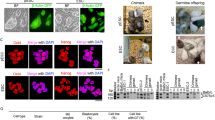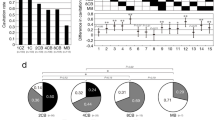Abstract
IN strain LT/Sv mice, eggs often begin to develop parthenogenetically in the ovary after the first meiotic division1–3. They undergo apparently normal cleavage and blastocyst formation, but at the egg cylinder stage they become disorganised and form teratomas. They persist as tumours composed of many kinds of tissue, indicating that cells of parthenogenetic origin are viable. Spontaneous parthenogenesis is also common in ovulated strain LT eggs. They cleave, form blastocysts and implant in the uterus, but die shortly afterwards, in the same way that embryos derived from experimentally induced parthenogenesis die early4–7. However, parthenogenetic cells have been ‘rescued’ by removing embryos from the oviducts of virgin females and grafting them to extrauterine sites such as testis1 and kidney8. Those embryos become disorganised and can survive as teratomas composed of many kinds of viable tissues. Why, then, do cells of parthenogenetic origin fail to survive in utero? To investigate this problem we are using chimaeras derived from aggregates of eight-cell parthenogenetic and normal embryos2, transferred to the uteri of pseudopregnant females. We report here that early embryonic parthenogenetic cells are totipotent. They can give rise to fully functional ova which, when fertilised by sperm, develop into normal individuals.
Similar content being viewed by others
References
Stevens, L. C. & Varnum, D. S. Devl Biol. 21, 364–382 (1974).
Stevens, L. C., Varnum, D. S. & Eicher, E. M. Nature 269, 515–517 (1977).
Eppig, J. J., Kozak, L. P., Eicher, E. M. & Stevens, L. C. Nature 269, 517–518 (1977).
Graham, C. F. Biol. Rev. 49, 399–422 (1974).
Tarkowski, A. K. in The Developmental Biology of Reproduction (eds Markert, C. L. & Papaconstantinou, J.) 107–129 (Academic, New York, 1975).
Kaufman, M. T., Barton, S. C. & Surani, M. A. Nature 265, 53–55 (1977).
Witkowska, A. J. Embryol. exp. Morph. 30, 547–560 (1973).
Iles, S. A., McBurney, M. W., Bramwell, S. R., Deussen, Z. A. & Graham, C. F. J. Embryol. exp. Morph. 34, 387–405 (1975).
Whitten, W. K. Adv. Biosci. 6, 129–139 (1971).
Russell, E. S. & Bernstein, S. E. in The Biology of the Laboratory Mouse (ed. Green, E. L.) 351–372 (McGraw-Hill, New York, 1966).
Whitney, J. B. III Biochem. Genet. 16, 665 (1978).
Illmensee, K. Gatlinburg Symp. on Genetic Mosaics and Chimeras in Mammals (ed. Russell, L. B.) (Plenum, New York, in the press).
Author information
Authors and Affiliations
Rights and permissions
About this article
Cite this article
STEVENS, L. Totipotent cells of parthenogenetic origin in a chimaeric mouse. Nature 276, 266–267 (1978). https://doi.org/10.1038/276266a0
Received:
Accepted:
Issue Date:
DOI: https://doi.org/10.1038/276266a0
- Springer Nature Limited
This article is cited by
-
The use of chimeric mice in studying the effects of genomic imprinting
Russian Journal of Developmental Biology (2000)
-
In vitro development of spontaneously activated bovine oocytes
Journal of Assisted Reproduction and Genetics (1996)
-
Tissue specific loss of proliferative capacity of parthenogenetic cells in fetal mouse chimeras
Roux's Archives of Developmental Biology (1995)
-
Distribution of androgenetic cells in fetal mouse chimeras
Roux's Archives of Developmental Biology (1995)
-
Proliferation and differentiation of androgenetic cells in fetal mouse chimeras
Roux's Archives of Developmental Biology (1995)





